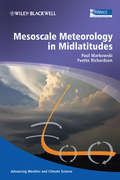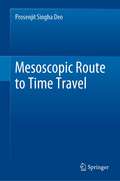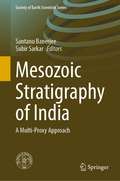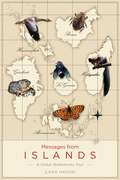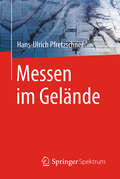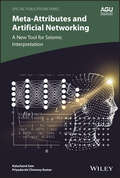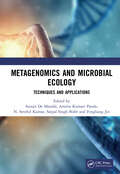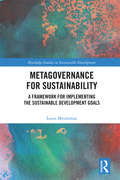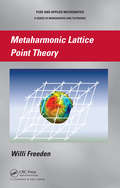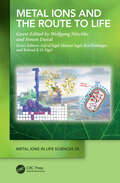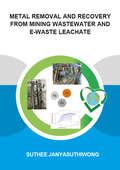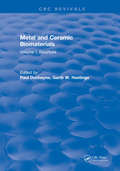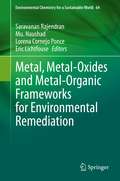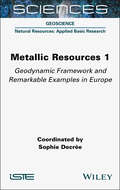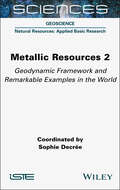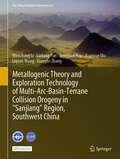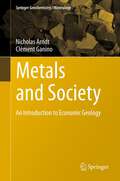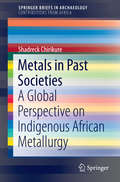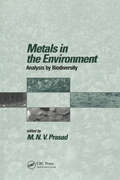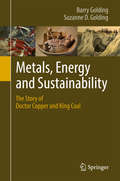- Table View
- List View
Mesoscale Meteorology in Midlatitudes
by Yvette Richardson Paul MarkowskiMesoscale Meteorology in Mid-Latitudes presents the dynamics of mesoscale meteorological phenomena in a highly accessible, student-friendly manner. The book's clear mathematical treatments are complemented by high-quality photographs and illustrations. Comprehensive coverage of subjects including boundary layer mesoscale phenomena, orographic phenomena and deep convection is brought together with the latest developments in the field to provide an invaluable resource for mesoscale meteorology students.Mesoscale Meteorology in Mid-Latitudes functions as a comprehensive, easy-to-use undergraduate textbook while also providing a useful reference for graduate students, research scientists and weather industry professionals.Illustrated in full colour throughout Covers the latest developments and research in the field Comprehensive coverage of deep convection and its initiation Uses real life examples of phenomena taken from broad geographical areas to demonstrate the practical aspects of the science
Mesoscale-Convective Processes in the Atmosphere
by Robert J. TrappThis new textbook seeks to promote a deep yet accessible understanding of mesoscale-convective processes in the atmosphere. Mesoscale-convective processes are commonly manifested in the form of thunderstorms, which are fast evolving, inherently hazardous, and can assume a broad range of sizes and severity. Modern explanations of the convective-storm dynamics, and of the related development of tornadoes, damaging "straight-line" winds, and heavy rainfall, are provided. Students and weather professionals will benefit especially from unique chapters devoted to observations and measurements of mesoscale phenomena, mesoscale prediction and predictability, and dynamical feedbacks between mesoscale-convective processes and larger-scale motions.
Mesoscopic Route to Time Travel
by Prosenjit Singha DeoThis book gives a general introduction to theoretically understand thermodynamic properties and response to applied fields of mesoscopic systems that closely relate to experiments. The book clarifies many conceptual and practical problems associated with the Larmor clock and thus makes it a viable approach to study these properties. The book is written pedagogically so that a graduate or undergraduate student can follow it. This book also opens up new research areas related to the unification of classical and quantum theories and the meaning of time. It provides a scientific mechanism for time travel which is of immense fascination to science as well as society. It is known that developments in mesoscopic physics can lead to downscaling of device sizes. So, new or experienced researchers can have a quick introduction to various areas in which they might contribute in the future. This book is expected to be a valuable addition to the subject of mesoscopic physics.
Mesozoic Mammals from South America and Their Forerunners (Springer Earth System Sciences)
by Analía M. Forasiepi Guillermo W. Rougier Agustín G. MartinelliThis book summarizes the most relevant published paleontological information, supplemented by our own original work, on the record of Mesozoic mammals’ evolution, their close ancestors and their immediate descendants. Mammals evolved in a systematically diverse world, amidst a dynamic geography that is at the root of the 6,500 species living today. Fossils of Mesozoic mammals, while rare and often incomplete, are key to understanding how mammals have evolved over more than 200 million years. Mesozoic mammals and their close relatives occur in a few dozen localities from Argentina, Brazil, Chile, Bolivia, and Peru spanning from the Mid- Triassic to the Late Cretaceous, with some lineages surviving the cataclysmic end of the Cretaceous period, into the Cenozoic of Argentina. There are roughly 25 recognized mammalian species distributed in several distinctive lineages, including australosphenidans, multituberculates, gondwanatherians, eutriconodonts, amphilestids and dryolestoids, among others. With its focus on diversity, systematics, phylogeny, and their impact on the evolution of mammals, there is no similar book currently available.
Mesozoic Stratigraphy of India: A Multi-Proxy Approach (Society of Earth Scientists Series)
by Santanu Banerjee Subir SarkarThis book envisages a multi-proxy approach using stable isotopes, geochemical proxies, magnetic susceptibility and associated biotic events for paleoclimatic and paleoenvironmental interpretations of the Mesozoic sedimentary record of India. Mesozoic rocks of India record abnormal sea level rise, greenhouse climate, intensified volcanism, hypoxia in seawater, extensive black shale deposition, and hydrocarbon occurrence. The Mesozoic has also witnessed mass extinction events, evolution of dinosaurs, and breakdown of the supercontinent Pangea and the formation of Gondwana. Although the Mesozoic geology of India has witnessed significant progress in the last century, literature survey reveals a huge gap in knowledge regarding sequence stratigraphy, chemostratigraphy and key geological events. A synthesis of sedimentological, paleontological and chemical data is included to presenting a comprehensive understanding of the Indian Mesozoic record to students, researchers and professionals.
Message Dissemination Techniques in Opportunistic Underwater Sensor Networks
by Ran Wang Linfeng Liu Jiagao WuThis book investigates the architectures and characteristics of OUSNs, the mobility models of OUSN nodes, the challenges of message dissemination, and some evaluation indexes of message dissemination. Then, this book provides some message dissemination techniques in OUSNs from the viewpoints of nodes and data messages, respectively. The proposed message dissemination techniques and their conclusions can provide some useful insights to improve the performance of data message dissemination and promote the future applications of OUSNs. Researchers and engineers in the field of underwater sensor networks can benefit from the book.
Messages from Islands: A Global Biodiversity Tour
by Ilkka HanskiFrom a small island in the Baltic Sea to the large tropical islands of Borneo and Madagascar, Messages from Islands is a global tour of these natural, water-bound laboratories. In this career-spanning work, Ilkka Hanski draws upon the many islands on which he performed fieldwork to convey key themes in ecology. By exploring the islands’ biodiversity as an introduction to general issues, Hanski helps us to learn how species and communities interact in fragmented landscapes, how evolution generates biodiversity, and how this biodiversity is maintained over time. Beginning each chapter on a particular island, Hanski dives into reflections on his own field studies before going on to pursue a variety of ecological questions, including: What is the biodiversity crisis? What are extinction thresholds and extinction debts? What can the biodiversity hypothesis tell us about rapidly increasing allergies, asthma, and other chronic inflammatory disorders? The world’s largest island, Greenland, for instance, is the starting point for a journey into the benefits that humankind acquires from biodiversity, including the staggering biodiversity of microbes in the ecosystems that are closest to us—the ecosystems in our guts, in our respiratory tracts, and under our skin. Conceptually oriented but grounded in an adventurous personal narrative, Messages from Islands is a landmark work that lifts the natural mysteries of islands from the sea, bringing to light the thrilling complexities and connections of ecosystems worldwide.
Messen im Gelände
by Hans-Ulrich PfretzschnerDer vorliegende Leitfaden erläutert Studierenden der Geowissenschaften die grundlegenden Techniken der Aufnahme geodätischer Daten, die Umsetzung solcher Daten in topographische Karten und Höhenprofile, aber auch die grundlegenden geologischen Messtechniken und die Erstellung geologischer Profile. Sowohl einfache "Freihandtechniken", die auch von einer Person beim Prospektieren angewendet werden können, wie auch der Einsatz professioneller Präzisionsinstrumente finden Eingang in dieses Buch. Im ersten Abschnitt werden Kartenkoordinatensysteme und der Umgang mit Kartenkoordinaten vorgestellt. Es schließt sich im zweiten Teil eine detaillierte Darstellung der für die Geowissenschaftlerin bzw. den Geowissenschaftler wichtigen geodätischen wie auch geologischen Messtechniken an sowie eine kurze Einführung in die Erstellung geologischer Profile. Das Lehrbuch schließt ab mit einer Instrumentenkunde, in welcher die bei den Messungen eingesetzten Instrumente vorgestellt werden.
Meta-attributes and Artificial Networking: A New Tool for Seismic Interpretation (Special Publications #76)
by Kalachand Sain Priyadarshi Chinmoy KumarMeta-Attributes and Artificial Networking Meta-Attributes and Artificial Networking A New Tool for Seismic Interpretation Seismic data gathered on the surface can be used to generate numerous seismic attributes that enable better understanding of subsurface geological structures and stratigraphic features. With an ever-increasing volume of seismic data available, machine learning augments faster data processing and interpretation of complex subsurface geology. Meta-Attributes and Artificial Networking: A New Tool for Seismic Interpretation explores how artificial neural networks can be used for the automatic interpretation of 2D and 3D seismic data. Volume highlights include: Historic evolution of seismic attributes Overview of meta-attributes and how to design them Workflows for the computation of meta-attributes from seismic data Case studies demonstrating the application of meta-attributes Sets of exercises with solutions provided Sample data sets available for hands-on exercises The American Geophysical Union promotes discovery in Earth and space science for the benefit of humanity. Its publications disseminate scientific knowledge and provide resources for researchers, students, and professionals.
Metagenomics and Microbial Ecology: Techniques and Applications
by Nachimuthu Senthil Kumar Surajit De Mandal Amrita Kumari Panda Satpal Singh Bisht Fengliang JinMicroorganisms comprise the greatest genetic diversity in the natural ecosystem, and characterization of these microbes is an essential step towards discovering novel products or understanding complex biological mechanisms. The advancement of metagenomics coupled with the introduction of high-throughput, cost-effective NGS technology has expanded the possibilities of microbial research in various biological systems. In addition to traditional culture and biochemical characteristics, omics approaches (metagenomics, metaproteomics, and metatranscriptomics) are useful for analyzing complete microbial communities and their functional attributes in various environments. Metagenomics and Microbial Ecology: Techniques and Applications explores the most recent advances in metagenomics research in the landscape of next-generation sequencing technologies. This book also describes how advances in sequencing technologies are used to study invisible microbes as well as the relationships between microorganisms in their respective environments. Features: Covers a wide range of concepts, investigations, and technological advancement in metagenomics at the global level. Highlights the novel and recent approaches to analyze microbial diversity and its functional attributes. Features a range of chapters that present an introduction to the field and functional insight into various ecosystems.
Metagovernance for Sustainability: A Framework for Implementing the Sustainable Development Goals (Routledge Studies in Sustainable Development)
by Louis MeulemanThe 17 Sustainable Development Goals (SDGs) which were adopted by the United Nations in September 2015 are universally applicable in all 193 UN Member States and connect the big challenges of our time, such as hunger and poverty, climate change, health in an urbanised environment, sustainable energy, mobility, economic development and environmental degradation. Sustainability has the characteristics of a ‘wicked problem’, for which there are no one-size-fits-all solutions. This book tests the hypothesis that the implementation of sustainable development, and in particular the 2015 SDGs, requires tailor-made metagovernance or ‘governance of governance’. This is necessary to develop effective governance and high quality and inclusive public administration and to foster policy and institutional coherence to support implementing the SDGs. Based on the growing literature on governance and metagovernance, and taking into account the specificities of societal factors such as different values and traditions in different countries, the book presents a framework for the design and management of SDG implementation. It shows how hierarchical, network and market governance styles can be combined and how governance failure can be prevented or dealt with. The book presents an overview of fifty ‘shades of governance’ which differ for each governance style, and a sketch of a concrete method to apply sustainability metagovernance. Metagovernance for Sustainability is relevant to academic and practitioner fields across many disciplines and problem areas. It will be of particular interest to scholars, students and policy-makers studying Sustainable Development, Governance and Metagovernance, Public Management and Capacity Building.
Metaharmonic Lattice Point Theory (Chapman & Hall Pure and Applied Mathematics)
by Willi FreedenMetaharmonic Lattice Point Theory covers interrelated methods and tools of spherically oriented geomathematics and periodically reflected analytic number theory. The book establishes multi-dimensional Euler and Poisson summation formulas corresponding to elliptic operators for the adaptive determination and calculation of formulas and identities of
Metal Ions and the Route to Life (Metal Ions in Life Sciences Series)
by Wolfgang NitschkeVolume 28, entitled Metal Ions and the Route to Life, of the series Metal Ions in Life Sciences, advocates for the prime importance of the recognition of metal ions and metal-bearing minerals in the transition from inanimate matter to first life on our planet. Unlike the relatively unreactive organic molecules, the traditional protagonists of orthodox origin-of-life hypotheses, metals and minerals are natural catalysts, abundantly present in the majority of settings on the early Earth considered as conducive to bringing forth life. In these palaeogeochemical settings, they may have catalyzed the anabolic conversions of inorganic precursor molecules into organics and may have converted redox disequilibria between environmental reductants and oxidants into the ordering, i.e. the lowering of entropy, of first living entities. Far-fetched? Yet, this is precisely what metal ions do in life today! An unlikely coalition of biology (biochemistry and bioenergetics) and physics (thermodynamics and condensed matter physics) is growingly questioning the plausibility of the orthodox hypotheses while putting metal ions and minerals centre-stage in their scenarios. In this volume, 29 internationally renowned experts from fields as diverse as microbiology, biochemistry, astrobiology, electrochemistry, ecology, mineralogy, geology and geochemistry shine light from their individual angles on this topic, bringing home metal ions’ primordial importance to extant life, presenting minerals with tantalizing reactivities appearing as look-alikes of life’s processes and sketching out plausible, metal-ion-based scenarios for life’s emergence on planet Earth. Metal Ions and the Route to Life provides the empirical groundwork to interested researchers and the general public for revisiting their preconceived ideas about the origin of life and for appreciating the absolute indispensability of metal ions in life – now just as at its beginnings!
Metal Removal and Recovery from Mining Wastewater and E-waste Leachate (IHE Delft PhD Thesis Series)
by Suthee JanyasuthiwongMetal contamination in the environment is a persisting global issue. The metal reservoirs in the earth have declined due to society’s needs and due to uncontrolled mining activities. Therefore, the idea to recover metals from waste streams has emerged. In this thesis, cost competitive technologies such as adsorption using agro-wastes and precipitation using an inverse fluidized bed (IFB) reactor were investigated, with special emphasis on the recovery of base metals. Groundnut shell showed good potential for metal (Cu, Pb and Zn) removal. From artificial neural network modeling, the performance of the sulfate reducing bacteria (SRB) was found to be strongly pH dependent; the removal efficiency of Cu and Zn in the IFB at pH 5.0 was >97%. Electronic waste is a good candidate as secondary metal resource. The recovery of Cu from computer printed circuited boards (PCBs) using biogenic sulfide precipitation was investigated as well. Using this technology, Cu could be recovered at ~0.48 g Cu/g PCBs.
Metal and Ceramic Biomaterials: Volume I: Structure
by DucheyneThe understanding of the in vivo performance of synthetic materials is largely dependent upon a profound knowledge of the properties of the materials in question. Analogous to materials science in its broadest sense, the basis for biomaterials science is formed by microstructural there. It is therefore, that in this series on structure property relationships in biomaterials a substantial part is devoted to the analysis of the basic properties of the various synthetic biomaterials. In addition, the effect of microstructural aspects on properties is considered at great length.
Metal and Ceramic Biomaterials: Volume II: Strength and Surface
by DucheyneThe understanding of the in vivo performance of synthetic materials is largely dependent upon a profound knowledge of the properties of the materials in question. Analogous to materials science in its broadest sense, the basis for biomaterials science is formed by microstructural there. It is therefore, that in this series on structure property relationships in biomaterials a substantial part is devoted to the analysis of the basic properties of the various synthetic biomaterials. In addition, the effect of microstructural aspects on properties is considered at great length.
Metal, Metal-Oxides and Metal-Organic Frameworks for Environmental Remediation (Environmental Chemistry for a Sustainable World #64)
by Eric Lichtfouse Mu. Naushad Saravanan Rajendran Lorena Cornejo PonceThis book reviews principles, techniques and applications of metal, metal oxides, metal sulfides and metal-organic frameworks for removal and degradation of pollutants. Natural materials are often much more advanced than synthetic materials in terms of circularity and are functional, often biodegradable, recyclable and generate little waste. They are, therefore, a source of inspiration for new synthetic materials. In particular, recent research has focused on various types of functional materials such as organic, inorganic, nanostructured and composites for the remediation of environmental pollution.
Metallic Resources 1: Geodynamic Framework and Remarkable Examples in Europe
by Sophie DecréeMetallic resources play a huge role in many fields: in the energy transition, the development of new technologies and the production and storage of green energy. Metallic Resources 1 presents various studies in notable European metallogenic regions or deposits that enable us to tackle the question of the concentration of metals, especially strategic metals, in various geodynamic settings. An understanding of the geological processes that lead to the formation of deposits and influence their concentrations in the Earth's crust is of the utmost importance when it comes to uncovering new mineral resources. This book puts forward various different methodological approaches necessary in the study of deposits of metallic resources, from field observations to microanalysis. A study of specific geo-politico-economic frameworks is also presented.
Metallic Resources 2: Geodynamic Framework and Remarkable Examples in the World
by Sophie DecréeMetallic resources play a huge role in many fields: in the energy transition, the development of new technologies and the production and storage of green energy. Metallic Resources 2 presents various studies in notable metallogenic regions or deposits worldwide that enable us to tackle the question of the concentration of metals, especially strategic metals, in various geodynamic settings. An understanding of the geological processes that lead to the formation of deposits and influence their concentrations in the Earth's crust is of the utmost importance when it comes to uncovering new mineral resources. This book puts forward various different methodological approaches necessary in the study of deposits of metallic resources, from field observations to microanalysis. A study of specific geo-politico-economic frameworks is also presented.
Metallogenic Theory and Exploration Technology of Multi-Arc-Basin-Terrane Collision Orogeny in “Sanjiang” Region, Southwest China (The China Geological Survey Series)
by Wenchang Li Guitang Pan Zengqian Hou Xuanxue Mo Liquan Wang Xiangfei ZhangThis open access book presents a new structural model of “multi-arc-basin-terrane system” based on the in-depth research of the Nujiang-Lancangjiang-Jinshajiang region, especially several Paleo-Tethys ophiolitic mélange belts and sets of arc-basin systems, and a new orogenic model of “The Hengduan shan Mountains” based on penetrated research on spatial-temporal framework and orogenic models of different orogenic belts under large-scale strike-slip-shear-nappe structures evolution. The authors paid special attention on the coupling relation between orogeny and metallogenesis. The metallogenesis and dynamic process are probed under the crust–mantle interaction and material-energy exchange-transmission background and the tectonic units evolution. The ore genesis and distribution of deposits have been thoroughly analyzed, and the metallogenic theories of "multi-arc-basin-terrane" and "intracontinental tectonic transformation" in the Nujiang-Lancangjiang-Jinshajiang region have been carried out. This book also illustrates how to explore metallic deposits in the Nujiang-Lancangjiang-Jinshajiang region by using the metallogenic regulations. Meanwhile, this book has high reference value for researchers working in the fields of basic geology, environmental geology, and energy geology.
Metals and Society
by Nicholas Arndt Clément GaninoIn the second edition Steve Kesler (University of Michigan) has been added as an author to rewrite some chapters. The motivation for this revised edition is to more intensively address economic issues that surround the exploitation of mineral resources. This emphasis gives the book a unique character. With these sections Metals and Society deals with issues that pervade much of current science reporting - the rate of exploitation of natural resources, the question of when or if these resources will be exhausted, the pollution and social disturbance that accompanies mining, the compromises and challenges that arise from the explosion of demand from China, India and other rapidly developing countries, and the moral issues that surround mining of metals in lesser developed countries for consumption in the "first-world" countries. With its dual character, the book will be useful as an introductory text for students in the earth sciences and a reference volume for students, teachers and researchers of geography, economics and the social sciences.
Metals and Society
by Nicholas Arndt Clément Ganino Stephen KeslerThis book is a comprehensive overview of economic geology for the general geologist and anyone else interested in the minerals industry and the global supply of raw materials. It includes some thought-provoking statements and questions for discussion on globalisation and current practices in the minerals industry. In the second edition, all chapters have been extensively revised, and a new author has been added to increase coverage of some mineral deposits and topics. The economic issues surrounding the exploitation of mineral resources is discussed in three of the six chapters of the book. It deals with issues that are commonly addressed in current science reporting - the rate of exploitation of natural resources, the question of when or if these resources will be exhausted, the pollution and social disturbance that accompanies mining, the compromises and challenges that arise from the explosion in demand from China, India and other rapidly developing countries, and the moral issues that surround mining of metals in lesser-developed countries for consumption in the "first-world" countries. The book will be useful both as an introductory text for students in the earth sciences and a reference volume for students, teachers and researchers of geography, economics and the social sciences.
Metals in Past Societies
by Shadreck ChirikureThis book seeks to communicate to both a global and local audience, the key attributes of pre-industrial African metallurgy such as technological variation across space and time, methods of mining and extractive metallurgy and the fabrication of metal objects. These processes were transformative in a physical and metaphoric sense, which made them total social facts. Because the production and use of metals was an accretion of various categories of practice, a chaine operatoire conceptual and theoretical framework that simultaneously considers the embedded technological and anthropological factors was used. The book focuses on Africa's different regions as roughly defined by cultural geography. On the one hand there is North Africa, Egypt, the Egyptian Sudan, and the Horn of Africa which share cultural inheritances with the Middle East and on the other is Africa south of the Sahara and the Sudan which despite interacting with the former is remarkably different in terms of technological practice. For example, not only is the timing of metallurgy different but so is the infrastructure for working metals and the associated symbolic and sociological factors. The cultural valuation of metals and the social positions of metal workers were different too although there is evidence of some values transfer and multi-directional technological cross borrowing. The multitude of permutations associated with metals production and use amply demonstrates that metals participated in the production and reproduction of society. Despite huge temporal and spatial differences there are so many common factors between African metallurgy and that of other regions of the world. For example, the role of magic and ritual in metal working is almost universal be it in Bolivia, Nepal, Malawi, Timna, Togo or Zimbabwe. Similarly, techniques of mining were constrained by the underlying geology but this should not in any way suggest that Africa's metallurgy was derivative or that the continent had no initiative. Rather it demonstrates that when confronted with similar challenges, humanity in different regions of the world responded to identical challenges in predictable ways mediated as mediated by the prevailing cultural context. The success of the use of historical and ethnographic data in understanding variation and improvisation in African metallurgical practices flags the potential utility of these sources in Asia, Latin America and Europe. Some nuance is however needed because it is simply naïve to assume that everything depicted in the history or ethnography has a parallel in the past and vice versa. Rather, the confluence of archaeology, history and ethnography becomes a pedestal for dialogue between different sources, subjects and ideas that is important for broadening our knowledge of global categories of metallurgical practice.
Metals in the Environment: Analysis by Biodiversity (Books in Soils, Plants, and the Environment)
by M.N.V. PrasadA summary of data on heavy metal accumulation, biomonitoring, toxicity and tolerance, metal contamination and pollution in the environment, and the importance of biodiversity for environmental monitoring and cleanup of metal-contaminated and polluted ecosystems. It advocates the use of bacteria, mycorrhizae, freshwater algae, salt marshes, bryo- an
Metals, Energy and Sustainability
by Suzanne D. Golding Barry GoldingThis book explains how and where copper and fossil fuels were formed and the likely future for the extraction of copper and coal. The colourful chronology of our efforts to extract metals from minerals and energy from fossil fuels is presented from earliest times until the present day. The difficult concept of human sustainability is examined in the context of continually decreasing real prices of energy and metals. This book integrates the latest findings on our historic use of technology to continually produce cheaper metals even though ore grades have been decreasing. Furthermore, it shows that the rate of technological improvement must increase if metals are to be produced even more cheaply in the future.
